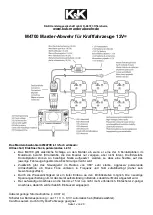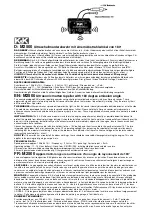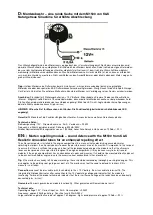
*
NOTE Damage to the drivetrain from
wheelspin
#
Avoid wheelspin.
The traction grades – from highest to lowest – are
AA, A, B and C. These grades relate to the tire's
ability to come to a standstill on a wet pavement
under controlled conditions on a specified U.S.
government test surface made from asphalt and
concrete.
Temperature grade
&
WARNING Risk of accident from tire over-
heating and tire failure
Excessive speed, underinflation, or excessive
loading, either separately or in combination,
can cause excessive heat build-up and possible
tire failure.
#
Observe the recommended tire pressure.
#
Regularly check the pressure of all the
tires.
#
Adjust the tire pressure, if necessary.
The temperature grades are A (highest grade), B
and C. These relate to a tire's resistance to heat
and its ability to release heat on a specified test
wheel in laboratory tests under controlled condi-
tions. Sustained high temperatures can cause the
material of the tire to degenerate and reduce tire
life. In addition, excessively high temperatures can
lead to sudden tire failure. Grade C refers to a per-
formance which all passenger vehicle tires must
exhibit, according to the U.S. Department of Trans-
portation's requirements.
Information on DOT and TIN (Tire Identification
Number)
U.S. tire regulations indicate that every tire manu-
facturer or retreader must imprint a TIN in or on
the sidewall of each tire produced.
%
The data shown in the illustration is sample
data.
The TIN is a unique identification number for tires
and consists of the following components:
R
DOT (Department of Transportation): tire sym-
bol
1
indicates that the tire complies with the
requirements of the U.S. Department of Trans-
portation.
R
Manufacturer identification code: manufac-
turer identification code
2
provides informa-
tion about the tire manufacturer. New tires
have a code with two symbols. Retreaded tires
have a code with four symbols. For further
information about retreaded tires, see
(
/
page 258).
R
Tire size: identifier
3
describes the tire size.
R
Tire type code: tire type code
4
can be used
by the manufacturer as a code to describe spe-
cific characteristics of the tire.
R
Date of manufacture: date of manufacture
5
provides information about the age of a tire.
The 1st and 2nd numbers indicate the calendar
week and the 3rd and 4th numbers indicate
the year of manufacture (e.g. "3208" refers to
the 32nd week of the year 2008).
Information on maximum tire load
%
The data shown in the illustration is sample
data.
Maximum tire load
1
is the maximum permissible
weight for which the tire is approved.
Do not overload the tires by exceeding the maxi-
mum permissible load. The maximum permissible
load can be found on the vehicle's Tire and Load-
ing Information placard on the B-pillar on the driv-
er's side (
/
page 251).
254 Wheels and tires
Содержание Sprinter
Страница 7: ......
Страница 12: ...NJ Brakes yellow 323 O ABS malfunction 323 På ESP deactivated 323 10 At a glance Instrument cluster ...
Страница 21: ...Example spare wheel 265 At a glance Emergencies and breakdowns 19 ...
Страница 213: ... A wheel arch may be subjected to a load of 330 lb 150 kg Transporting 211 ...
Страница 354: ......
















































